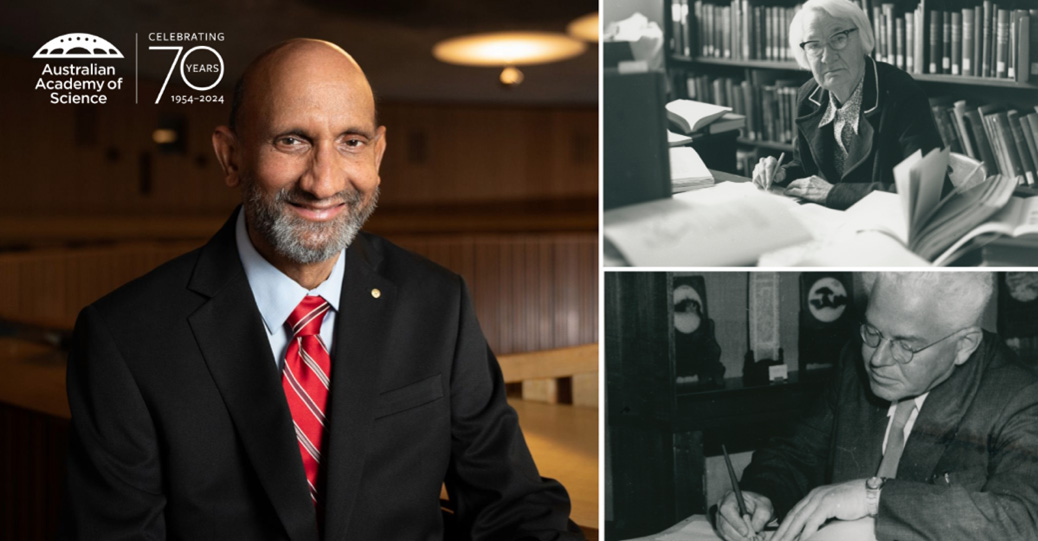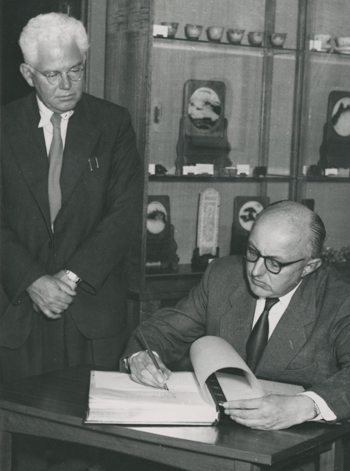
Today, the Australian Academy of Science celebrates seven decades of serving the nation as the home of science.
Discussion of the Academy began in 1951 when leading scientists, technologists and industrialists met in Canberra to talk about the future of science and technology in Australia, ultimately deciding there was a need for a national establishment of scientists.
Earlier attempts to establish such an organisation had been unsuccessful, but with scientific capacity and capability accelerating in Australia, the need for this organisation was now urgent.
Renowned physicists Sir Mark Oliphant AC KBE FAA FTSE FRS and Dr David Martyn FAA FRS championed the initiative.
“If science for its own sake was to have coherence, there must be a means whereby that coherence could be expressed,” Oliphant said at a seminar in 1951, when convincing others of the possibilities of an Australian Academy.
He went on to say, “most countries have a National Academy of Science, Britain has its Royal Society” and, because of the great talent and growing capability of Australian scientists, he was inspired to establish a national scientific identity closer to home.
Above: Watch Robyn Williams AM FAA in discussion with Michael Wilson, Sir Mark Oliphant’s grandson, about Oliphant’s legacy and vision for science in Australia. See the full interview (30mins)
The collaboration between Oliphant and Martyn overcame the difficulties that had defeated previous attempts to form an Academy, and together they organised the Petition to Queen Elizabeth II requesting the formation of the Australian Academy of Science.
On this day in 1954 the founding members of the Academy’s first Council, originally just ten members of the United Kingdom’s Royal Society, gathered in a small room at Government House to receive the Academy’s founding document, the Royal Charter, from the Queen.
The Royal Charter establishes the Academy as an independent body with government endorsement, and independence remains a talisman of the organisation.

Oliphant was the Academy’s first President, choosing to stay in Australia to continue to build research capacity and advocate for the organisation of scientists in this country – instead of pursuing what might have been a lucrative research career overseas.
“(I have a) deep confidence in the part which science can play in making us strong and prosperous, and an idea that the proper use of science within its diverse territories may point the way to a secure and good life for all,” Oliphant said, about staying in Australia to establish a home for science.
Current President of the Academy Professor Chennupati Jagadish AC, said the establishment of the Academy created the opportunity to recognise local talent, make their expertise available domestically and to grow recognition of Australia’s contribution on the global stage.
“We strive to ensure that wherever decisions are made, they are informed by evidence, whether that be in our parliaments, courtrooms, boardrooms, classrooms or in the public square,” he said.
To this day, the Academy remains an independent organisation of distinguished Australian scientists, championing science for the benefit of all – with 915 Fellows elected to the Academy from 1954 to 2023.
“We are non-partisan, we do not carry vested interests, we are not a governmental organisation, and we are not beholden to any single institution,” Professor Jagadish said.
And while the home of the Academy may be in Canberra, it is a truly national organisation, with Fellows elected from every state and territory in Australia.
From the invention of the Wi-Fi router to the development of the world’s first anti-cancer vaccine (Gardasil), the creation of spray-on skin for burn treatment and world-leading progress in gravitational wave detection and energy efficient solar cells, Fellows of the Academy are elected for their outstanding contributions to science.
We invite all Australians, from every corner of society, to collaborate with us to benefit from the value of science and share in the treasure that is our Fellowship and the knowledge they generate and share. — Professor Jagadish
The Academy is built on the vision of bringing scientists together as part of a national identity, now providing a valuable window into the history of Australian scientific discovery and serving as a springboard for scientific collaboration and education in Australia.
“As we enter our eighth decade we are as committed as ever to our mission to advance Australia as a nation that embraces scientific knowledge and whose people enjoy the benefits of science,” Professor Jagadish said.
“As we look to the future, the Academy will continue to work with you to ensure a healthy science system and make the best expertise available to the service of the nation.”
The Academy is celebrating seven decades of scientific excellence with a full calendar of events, to reflect on its vivid history and look to the future of science.
There will be a six-part public speaker series with events throughout the year, the annual symposium will be held during the World Science Festival in Brisbane and Science at the Shine Dome will be in September. Keep an eye on the Academy’s events page to join in the festivities.
70th anniversary President’s message
We are 70 years young – here are some things you might not know about us
© 2025 Australian Academy of Science